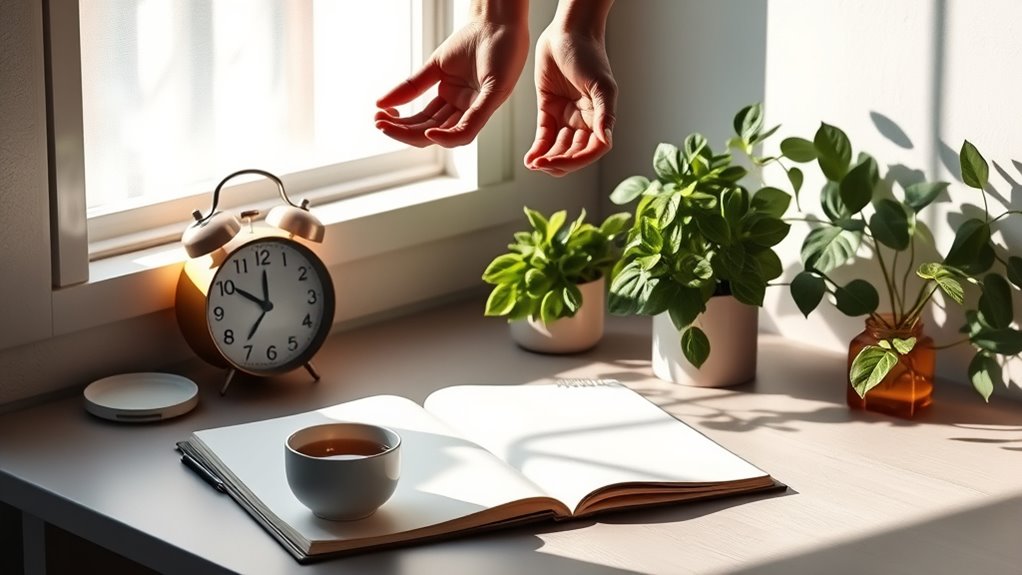Mindfulness is a game-changer for designers like you. It boosts your creativity by enhancing focus and reducing stress. By practicing mindfulness, you’ll build empathy for users, leading to meaningful designs that address their needs. Simple techniques, such as deep breathing or mindful walking, can integrate seamlessly into your routine, fostering collaboration and innovation within your team. Embracing mindfulness truly transforms your design process and workspace, making it more effective. Discover how it can elevate your design experience even further.
Key Takeaways
- Mindfulness enhances creativity by promoting non-judgmental attention and cognitive flexibility, leading to original ideas and innovative design solutions.
- Regular mindfulness practices, like meditation and deep breathing, reduce stress and improve focus, facilitating better problem-solving in design tasks.
- Empathy cultivated through mindfulness allows designers to deeply understand user needs, resulting in more meaningful and user-centered designs.
- Incorporating mindfulness into team collaboration fosters active listening, reduces misunderstandings, and builds trust, enhancing overall productivity and job satisfaction.
- A mindful workspace, characterized by organization and natural elements, optimizes focus and encourages a reflective approach to the design process.
Understanding Mindfulness in Design
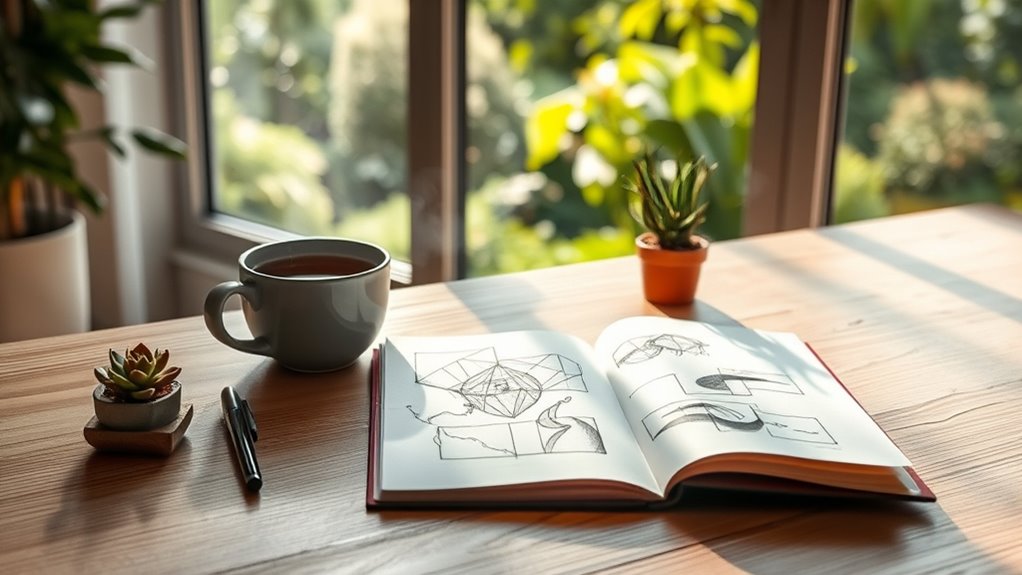
As you dive into the world of design, understanding mindfulness can significantly enhance your creative process. Mindfulness means paying attention non-judgmentally to the present moment, which can boost your awareness and empathy.
You can weave mindfulness into every stage of your design process, from finding inspiration to implementing your ideas. By practicing mindfulness regularly, you’ll improve your focus, reduce stress, and enhance your overall well-being.
Techniques like meditation and body scanning can help you manage stress and keep your creativity flowing. Additionally, mindfulness fosters empathy, allowing you to better understand user needs and create more meaningful designs.
Embracing these principles can lead to a more thoughtful and impactful design experience.
The Role of Mindfulness in Enhancing Creativity
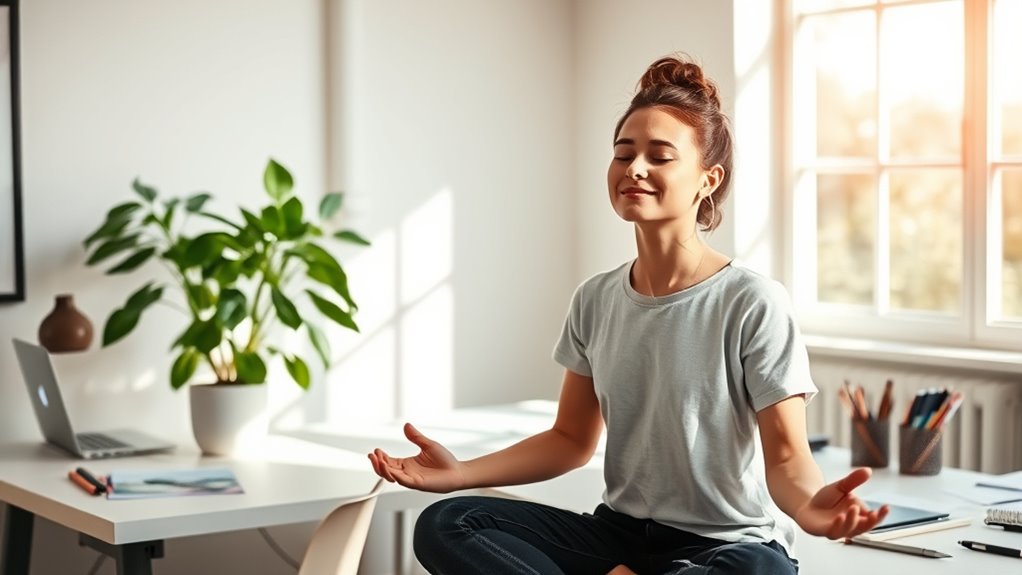
Mindfulness doesn’t just enhance your awareness and empathy; it also plays a vital role in boosting creativity. By promoting cognitive flexibility, mindfulness encourages you to explore fresh perspectives and engage in divergent thinking, which is essential for generating original ideas.
With heightened awareness, you notice subtle details and form novel connections, further enhancing your creative potential. Reducing stress creates a mental environment that fosters openness and experimentation, critical for innovative thinking.
Improved focus aids both divergent and convergent thinking, supporting effective problem-solving. Additionally, mindfulness fosters empathy and connection, enriching collaboration and user-centered design.
Benefits of Mindfulness for Designers
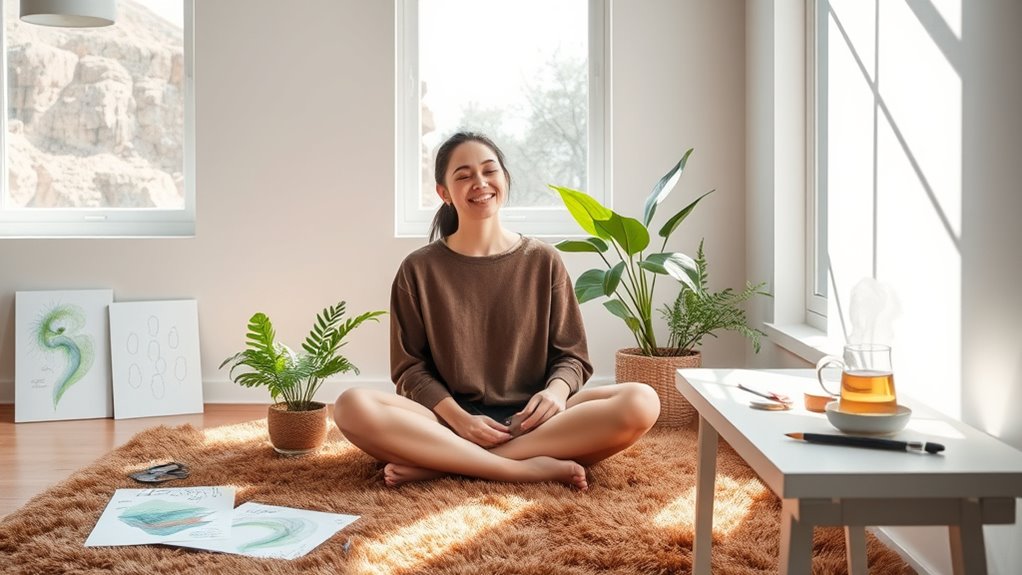
When you integrate mindfulness into your design practice, you unlock a range of benefits that can significantly enhance your work.
You’ll notice improved self-awareness, allowing you to manage biases and emotions more effectively. With regular mindfulness practice, your concentration and mental clarity will improve, helping you tackle complex design tasks with ease.
You’ll also cultivate greater empathy, enabling you to understand users’ needs more deeply. Mindfulness reduces stress, creating a more stable and productive environment.
Additionally, it promotes a holistic approach to design, integrating user well-being and sustainability into your decisions.
Embracing mindfulness not only enhances your design outcomes but also enriches your overall creative journey, making your work more meaningful and impactful.
Mindfulness Practices to Incorporate Into Daily Routines
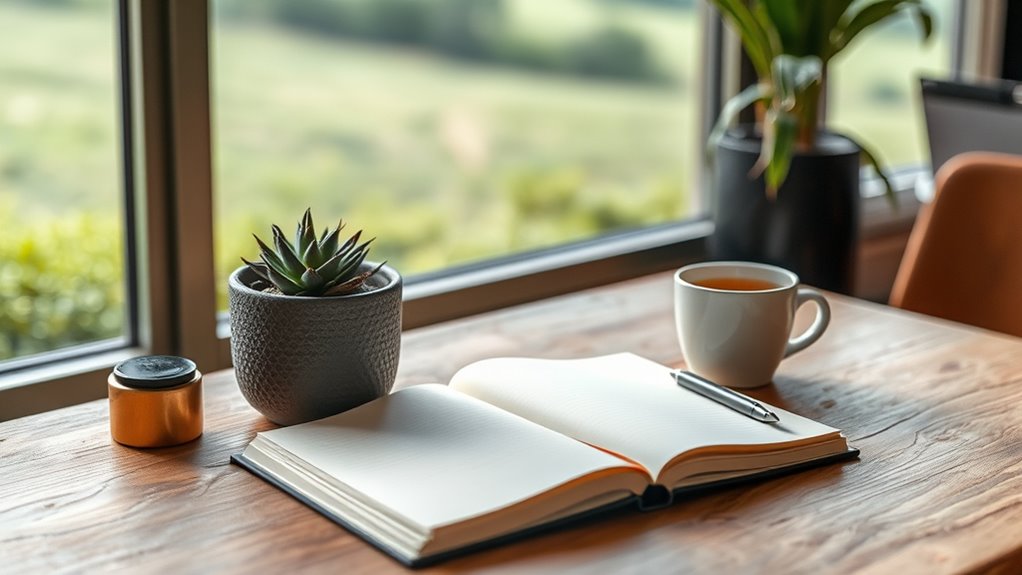
Incorporating mindfulness into your daily routines can transform how you approach design and life overall.
Start each morning with deep breathing exercises to create a sense of calm. Set intentions for your day, fostering a mindful and kind mindset.
Begin your day with deep breaths and intentions, nurturing a calm and compassionate mindset.
As you go through your morning routine, engage your senses—notice the temperature of the water and the sounds around you. Practice mindful eating by savoring each bite of breakfast.
Throughout the day, take mindful walks, concentrating on your surroundings. When stress arises, focus on your breath to regain composure.
Turn mundane tasks into mindful exercises by paying attention to sensations.
Finally, reflect on your day each evening, acknowledging moments of gratitude to cultivate a positive outlook.
Applying Mindfulness in the Design Process
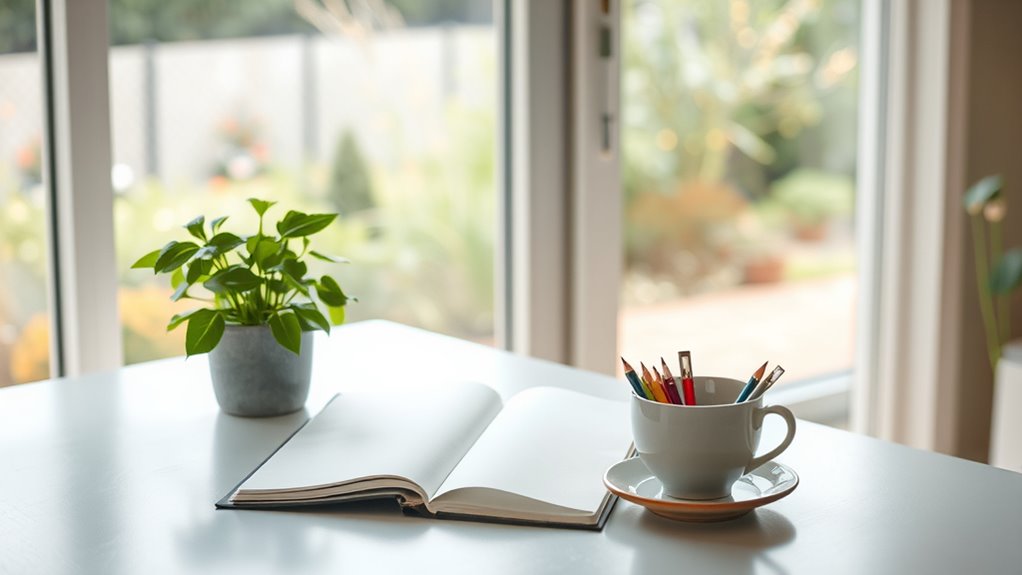
Embracing mindfulness during the design process can significantly enhance your creativity and problem-solving skills. By adopting a beginner’s mindset, you open yourself to new possibilities, fostering innovative ideas.
Mindfulness reduces anxiety, allowing you to concentrate fully on your work. Increased awareness of your thoughts and distractions leads to higher-quality outcomes. Remember to let go of expectations—forcing insights stifles creativity.
Reflecting on past projects can help you identify areas for improvement and enhance your learning. Additionally, applying techniques like visualization and simplification can streamline your design process, making it more effective.
Ultimately, mindfulness empowers you to empathize with users, creating designs that truly resonate with their needs. Incorporating intentional living into your design philosophy can deepen your connection to both your work and your audience.
Fostering Team Collaboration Through Mindfulness
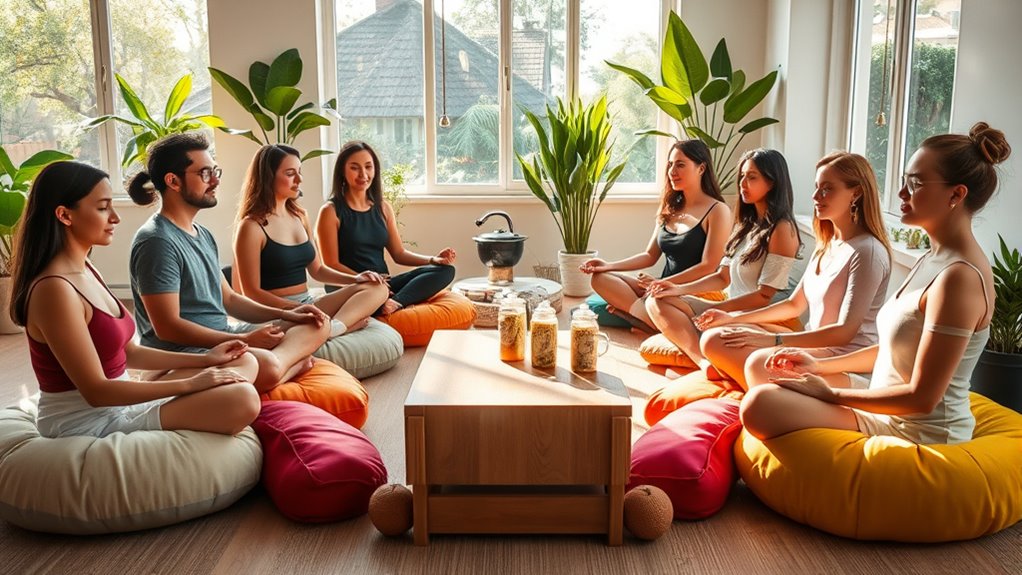
Designers often work in teams where collaboration is key to success. By incorporating mindfulness, you can significantly enhance communication and build stronger relationships within your team.
Mindfulness encourages active listening, reducing misunderstandings and fostering an environment of trust. When you practice empathy and perspective-taking, you’ll find that conflicts are managed more effectively, transforming potential disagreements into opportunities for growth.
A focus on the present moment also helps reduce stress, creating a more relaxed atmosphere that boosts job satisfaction. With regular mindfulness practices, your team can experience increased productivity and psychological safety, leading to improved decision-making and enhanced creativity. Additionally, embracing continuous learning through mindfulness can help team members adapt better to changing design requirements and challenges.
Ultimately, fostering mindfulness in teamwork not only strengthens bonds but elevates the entire design process.
Mindfulness and User-Centered Design
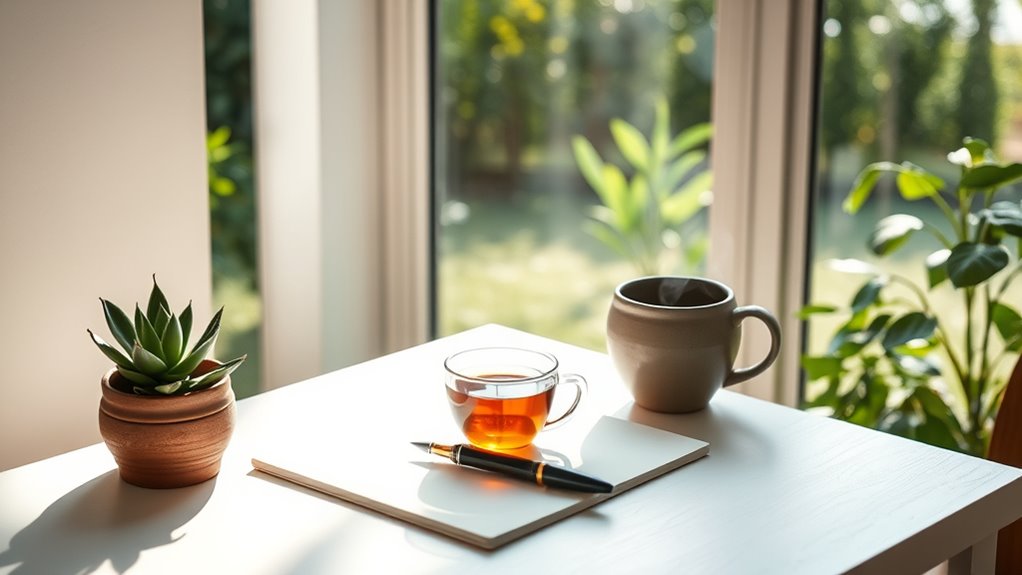
While creating user-centered designs, integrating mindfulness can profoundly impact how you understand and respond to user needs.
Mindfulness enhances your empathy, allowing you to connect deeply with users, which leads to more personalized experiences. By maintaining focus on the design process, you can foster creativity and innovation, resulting in intuitive solutions that resonate with users.
Additionally, practicing mindfulness encourages a holistic approach, promoting accessibility and sustainability in your designs. Engaging with users for feedback helps refine your work, ensuring it meets their preferences.
Ultimately, mindfulness cultivates an environment where user experience thrives, leading to greater satisfaction and stronger connections between users and their surroundings.
Embracing mindfulness transforms your design practice into a more empathetic and effective process.
Managing Stress and Improving Focus With Mindfulness
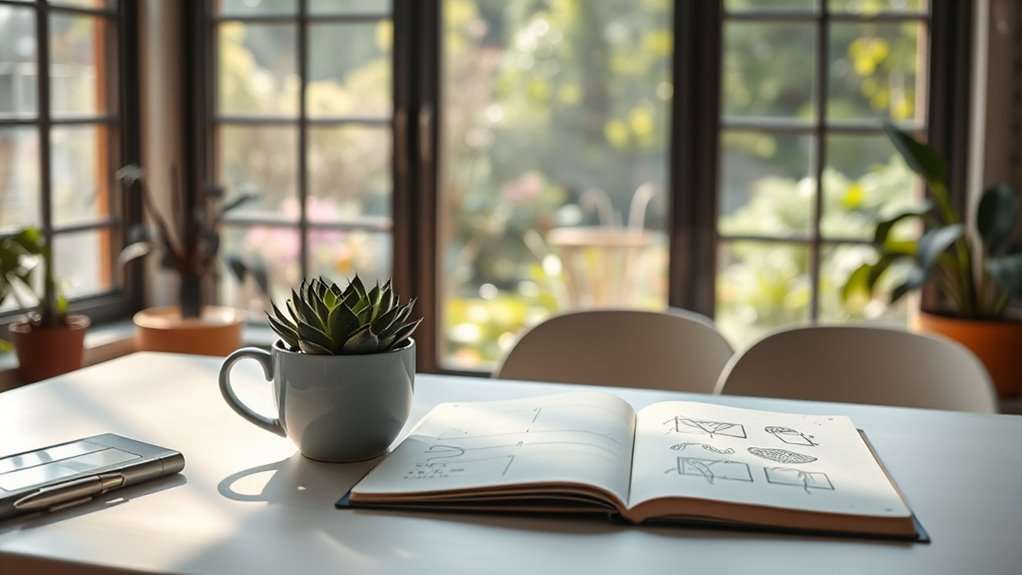
Integrating mindfulness into your design process not only enhances user empathy but also helps manage stress and sharpen focus.
High stress levels are common in the workplace, impacting productivity and mental clarity. Mindfulness practices can significantly reduce anxiety and depression, promoting a healthier work environment.
By engaging in mindfulness meditation, you improve your attentional regulation and cognitive flexibility, making it easier to concentrate on design tasks. This focus results in better job performance and satisfaction.
Additionally, designing mindful spaces with natural elements and ergonomic principles can further alleviate stress. Research shows that foods rich in omega-3 fatty acids can support cognitive function, enhancing your ability to focus while designing.
Prioritizing mindfulness not only enhances your well-being but also leads to more effective and innovative design outcomes.
Embrace mindfulness to transform stress into clarity and creativity.
Mindfulness for Innovative Design Outcomes
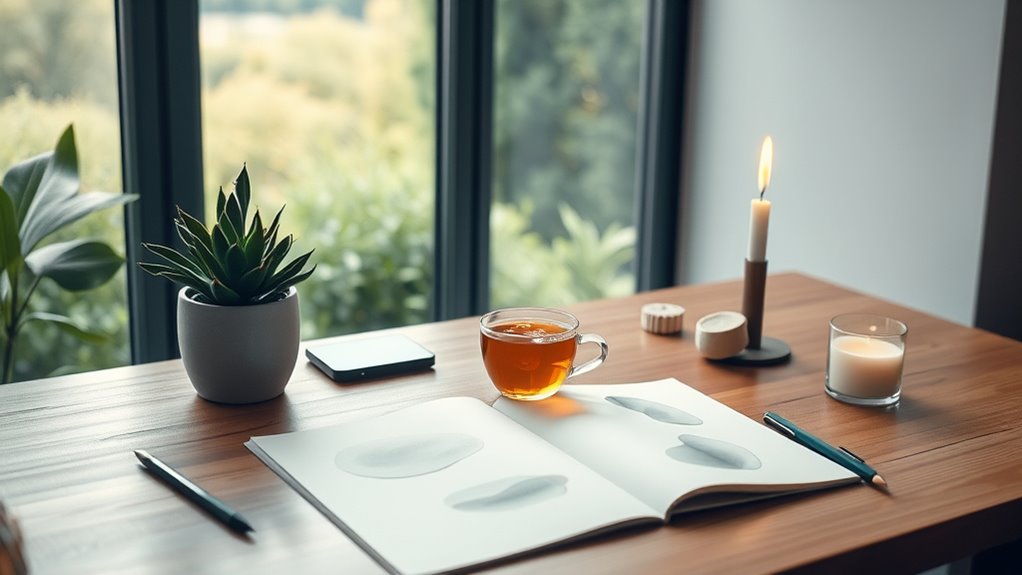
How can mindfulness reshape the way you approach design? By fostering a reflective practice, mindfulness encourages you to think outside the box, leading to innovative and effective solutions.
It helps you stay focused on the present, reducing distractions and enhancing productivity. When you take the time to slow down, you evaluate options more thoughtfully, resulting in sound decision-making.
Mindfulness promotes a holistic view of design, considering long-term impacts and the needs of all stakeholders. This approach not only aligns your designs with organizational values but also fosters socially responsible outcomes. Additionally, continuous learning within your design practice can enhance adaptability and innovation, driving better design solutions.
Ultimately, integrating mindfulness into your design process can unlock your creative potential, enabling you to tackle complex problems from multiple perspectives and generate groundbreaking ideas.
Cultivating a Mindful Design Environment
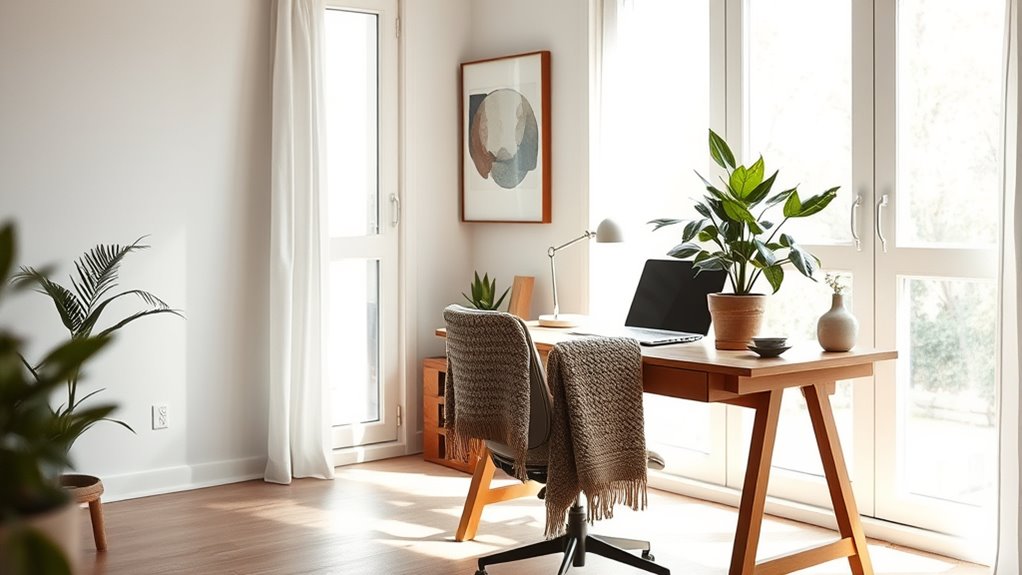
A mindful design environment is essential for fostering creativity and enhancing well-being among designers.
Begin your day with mindful breathing exercises to ground yourself, boosting awareness and calmness. Cultivate self-awareness by recognizing your thoughts and emotions, allowing you to approach tasks with clarity.
Start your day with mindful breathing to enhance awareness and clarity, setting a calm tone for your creative tasks.
Pay attention to details in your surroundings—this mindful noticing sharpens your focus. Create dedicated spaces for meditation or yoga, and incorporate natural elements for a serene atmosphere.
Keep your workspace clutter-free and maximize natural lighting to uplift your mood. Regularly reflect on your design process to spark iterative improvements.
Practicing gratitude for positive aspects of your work promotes a healthier mindset and fuels your creativity. Embrace these practices to cultivate a truly mindful design environment.
Frequently Asked Questions
How Can Mindfulness Help With Overcoming Creative Blocks?
Mindfulness can significantly help you overcome creative blocks by enhancing your focus and reducing self-judgment.
When you practice mindfulness, you learn to identify emotional barriers that hinder your creativity, allowing you to address them openly. It also encourages you to embrace constraints as opportunities for innovation.
Is There a Specific Time of Day Best for Mindfulness Practice?
There’s no one-size-fits-all answer to when you should practice mindfulness.
Whether you prefer the early morning’s peace, the midday’s refreshment, or the evening’s calm, each time has its benefits.
Morning sessions set a positive tone, midday breaks boost creativity, and evening practices help you unwind.
What matters is finding a time that fits your schedule and feels right for you, making mindfulness a consistent part of your daily routine.
Can Mindfulness Improve My Design Skills Quickly?
Absolutely, mindfulness can boost your design skills quickly.
By practicing mindfulness, you clear your mind and enhance focus, which helps you tackle design challenges with greater creativity and clarity.
Regular mindfulness exercises can reduce stress, allowing you to approach tasks with a fresh perspective.
This shift in mindset can lead to innovative solutions and better decision-making, ultimately improving your overall design process and outcomes in a short amount of time.
What Are Some Common Misconceptions About Mindfulness in Design?
Imagine a tree rooted deeply, yet swaying gracefully in the wind. That’s mindfulness—it’s not just about meditation or a specific posture.
You don’t need to be present all the time; it’s about awareness and acceptance. Many think mindfulness is a one-time achievement or only for relaxation, but it’s a continuous journey.
It doesn’t solve every problem, but it enhances clarity and focus, benefiting you in both personal and professional realms.
How Do I Integrate Mindfulness Into Team Meetings Effectively?
To integrate mindfulness into team meetings effectively, start by incorporating mindful breathing at the beginning to set a calm tone.
Encourage brief guided meditations to enhance focus, and promote mindful speech to improve communication.
Set clear intentions for each meeting to maintain purpose.
Consider adding short mindfulness breaks to keep energy levels up.
Regularly engage the team in feedback about these practices to ensure they’re beneficial and foster a culture of mindfulness together.
Conclusion
Incorporating mindfulness into your design practice is like planting seeds in a garden; with patience and care, creativity flourishes. By nurturing your focus and embracing the present moment, you’ll unlock innovative ideas that resonate deeply with users. As you cultivate a mindful environment, stress will ebb away, leaving space for inspiration to bloom. Embrace these practices, and watch your design journey transform into a vibrant tapestry of creativity and connection, where every project is a reflection of your mindful spirit.

